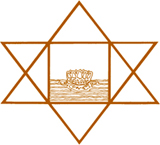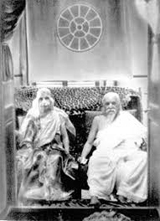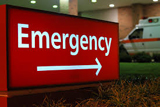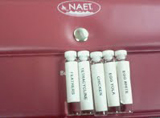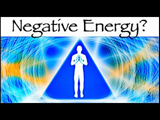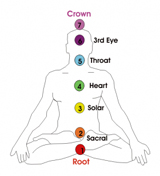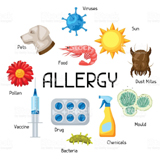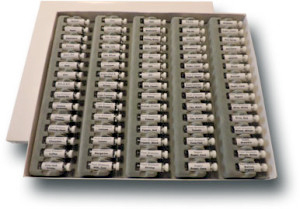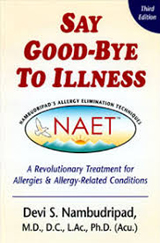Kinesiology
Integral Yoga / bio-energetic healing system
Abstract
As a comprehensive healing system, IY/BE represents a synthesis of the Integral Yoga healing and a bio-energetic approach. The practitioner asks for divine guidance while preparing for and implementing the healing procedure. At the outset, a disorder is examined in terms of bio-energetic causal factor(s), usingApplied Kinesiology muscle-testing for a series of key criteria and sub-criteria. For the initial healing stage, the client is asked to attend a centre where an Integral Bio-Energetic Field (IBEF) of healing vibrations had previously been created, induced and verified. If additional in-depth healing is needed, a second IY/BE stage is activated, based on a modified treatment modality known as Nambudripad Allergy Elimination Technique (NAET). The client is muscle-tested before and after treatment while holding a water-filled vial(s), computer-sensitized for a specified allergen substance.
Introduction
The overall healing system (IY/BE) can be viewed as a synthesis of Integral Yoga (Sri Aurobindo) healing principles in conjunction with a two-stage modality of bio-energetic healing. The practitioner, an aspirant of Integral Yoga, asks the Divine Mother for guidance and Grace while preparing for and activating the IY/BE system. At the outset, the aim is to identify a possible disorder(s) in terms of bio-energetic causal factors — based on Applied Kinesiology muscle-testing of key criteria (KC) and sub-criteria (SC), as described below. Focusing on the identified criteria factors, IY/BE treatment is applied, followed by re-testing to verify full clearance of the factors.
For the two-stage system, the initial IY/BE modality involves a vibrational healing environment referred to as the Integral Bio-Energetic Field, previously created, induced, and established at several centres (1). Brief exposure by the client to an IBEF centre has been shown to support overall health and resolve healing issues, as needed(2), e.g., elimination of allergies; reduction of inflammation and toxicity; physical and emotional balancing; as well as clearance of existing pathogens.
Following the IBEF centre attendance, additional in-depth healing maybe needed. For this second stage, the system applies a modified version of the method known as Nambudripad Allergy Elimination Technique (NAET). Based on methods of Oriental medicine, NAET has been demonstrated to be effective according to a series of peer-reviewed, controlled studies (3).
Summarised below are five major aspects to be considered while initiating the IY/BE system. They are: 1. divine guidance; 2. emergency medical help; 3. possible initial hindering factors; 4. disorder identification and causal factor(s), in terms of key criteria and sub-criteria; and 5. activation of the system’s two treatment stages, indicated above. The five aspects are briefly reviewed below and elaborated in the appendices.
1. Divine guidance (DG)
As mentioned above, the practitioner would regard self as a devotee and aspirant of the Integral Yoga conveyed by Sri Aurobindo and the Divine Mother (4). Thereby, he/she would deeply surrender to their guidance before and during the IY/BE procedure and be conscious that the two stages of healing are basically enabled by the divine Grace.
2. Emergency medical help (EMH)
For the first criterion, prior to the IY/BE system activation, the need for EMH would be carefully considered. Depending on the nature of symptoms, actual or potential seriousness of a disorder, EMH may be required. Thus, it may be critical to seek EMH, even call an ambulance for emergency transportation to a medical facility. Examples are possible signs of a heart attack, stroke, persistent bleeding, or constant severe pain.
For the second criterion, overall medical diagnosis and treatment (MDT) are recommended before initiating the IY/BE system; likely benefits are reviewed in Appendix 1.
3. Potential hindering factors (PHF)
Prior to starting IY/BE, several potential hindering factors (PHF) may exist — to be identified if present and cleared — for both the practitioner and client. This step is essential to ensure subsequent accurate testing of the system. The PHF procedure is detailed in Appendix 2.
4. IY/BE criteria
The system’s key criteria (KC) and sub-criteria (SC) are listed below, and reviewed in appendices 3 and 4.
Key criteria (KC)
1. Emergency medical help (EMH)
2. Potential hindering factors (PHF) — as per section 3) above
3. Medical examination/diagnosis, treatment (MEDT)
4. Integral Yoga balance (IYB) — physical, vital and mental bodies
5. Overall health (OH%); seriousness (1-6); functionality (FU%); resilience (RES%)
6. Symptom(s) (SYMP); body system analysis
7. Pathogens
8. Allergens/bio-incompatible substances
9. Genetic disorder
10. Age-related
11. Deficiency: nutritional
12. Psychological
13. Other criteria
Sub-criteria (SC)
1. Environmental factors (EFS)
2. Lifestyle (LIS)
3. Character improvement (CHIT)
5. IY/BE procedure
Sequential steps for activating IY/BE are as follows:
1. QRT muscle-test to estimate the number of relevant KC and SC criteria (Appendix 1); additional criteria may, however, emerge during the detection/healing stages.
2. QRT-test for the status of KC and SC criteria:
a. current criteria;
b. Underlying causal criteria;
c. Other criteria associated with disorder complication(s), including linkage between a symptom(s) and criteria. Relevant criteria would be labelled accordingly: a, b, or c.
3. Using QRT-testing, determine the healing priority of the relevant KC and SC criteria: high, medium, or low. Subsequent treatment would be carried out in this order.
4. Begin treatment with IY/BE stage 1: client exposure to the healing environment at an IBEF centre — to address basic healing issues.
5. Thereafter, QRT testing will indicate if the IBEF treatment was sufficient or additional bio-energetic healing is needed — as per step 6.
6. For additional treatment, a modified version of the Nambudripad Allergy Elimination Technique (NAET) (6), summarised in Appendix 6, would be applied. The procedure involves PDM-testing — the client holding vials sensitized for specified substances in order to detect any allergic reaction. The reactive vial(s) is held by the client during the NAET treatment procedure. Upon completion, the vial(s) is re-tested to verify non-reactivity.
7. Compensatory healing. IY/BE may be limited as to its healing potential for chronic illness and deep disorders. For these conditions, in-depth medical diagnosis and treatment might be required. Despite such limitations, IY/BE may still provide compensatory/adjunctive forms of healing — e.g. eliminate or diminish symptoms, address bio-energetic causal factors, balance body components or engender wellness. Possible healing benefits could be assessed periodically with QRT- and PDM-testing.
8. As an optional IY/BE phase, the practitioner would periodically re-test the identified KC and SC criteria. If any residual reactivity is found, the above steps may need to be re-applied.
Conclusion
As a pilot approach, IY/BE criteria for disorder detection, causal analysis, and treatment facilitate a wide range of potential bio-energetic healings. The two IY/BE stages for treatment are further reviewed in Appendix 7. As pointed out above, the practitioner would be an aspirant of Integral Yoga, with awareness and trust that the IY/BE healings are guided by the divine Grace. Looking ahead, additional studies are advisable so as to examine, broaden, and verify the system’s criteria and procedure. The investigation may, as feasible, include case studies involving pre-post testing to demonstrate the system’s overall effectiveness and sustainability.
Appendix 1: muscle testing
Based on Applied Kinesiology, Pre-Determined Muscle Testing (PDM) is performed as follows:
1. The recipient holds a water-filled vial, which had been computer-sensitized for a specified and potentially allergic substance.
2. The practitioner presses gently on the upper wrist of the recipient’s extended arm, while the latter resists the pressure. Normal muscle strength indicates non-reactivity/non-allergic response; a relatively weak muscle reaction indicates an allergic response.
For a second type of testing, referred to as Question-Response-Testing (QRT), the practitioner:
1. Asks a health-related question — e.g. ‘Is the client energetically balanced?’
2. Muscle-tests himself on behalf of the client: the tip of the middle-finger is pressed on top of index-finger (above finger-nail). Normal muscle strength signifies a ‘Yes’; a relatively weak muscle indicates a ,’No’, answer.
Appendix 2: possible hindering factors (PHF)
Five PHF factors need to be initially tested for possible presence and cleared in order to avoid subsequent biased IY/BE testing:
1. Entity (NEC): a negative energy cluster, generally transmitted from someone or emerging internally due to stress. Detect with QRT-testing:
a. Ask ‘Is an entity (NEC) currently present for (name self, or client)?’
b. If ‘Yes’, state: ‘With the Divine Mother’s Grace, may the entity be cleared’;
c. Next, repeat above a): expect ‘No’, indicating NEC clearance; if still ‘Yes’, however, repeat b) and c).
2. Deep Entity (DNE): negative energy cluster at a deep level, includes two generic sub-entities. Detect with QRT-testing:
a. Ask ‘Is a deep entity (DEN) currently present for (name self or client)?’ If ‘Yes’, say: ‘With the Divine Mother’s Grace —(state for successive steps):
1. ‘May the deep entity be cleared’;
2. ‘May its first generic sub-entity be cleared’;
3. ‘May its second generic sub-entity be cleared.’
4. QRT: ‘Has the deep-entity been cleared?’ Expect ‘Yes’; if ‘No’, repeat steps 1-4.
b. Ask ‘Is a hidden deep entity (HDEN) currently present for (name self or client)?’ If ‘Yes’, repeat the above a) procedure, but include the word ‘hidden’.
3. Bio-energetic imbalance (BEI): drawing upon Chinese medicine, a bio-energetic imbalance can be identified and corrected (6), for self or client:
Step 1
a. Place index and middle finger of right hand slightly above middle of eyebrows, and PDM-test: expect normal muscle strength.
b. Use prior placement, but place index and middle fingers in reverse (backwards) above middle of eyebrows; next, repeat PDM-test: expect muscle weakness. If the a. and b. pattern is not found, proceed with Steps 2 and 3.
Step 2
a. Place right hand on Point 1, called ‘Sea of Energy’, with tips of three fingers (index, middle, and ring) 1 inch below the navel; also
b. Place left hand’s three finger tips on Point 2, named ‘Dominating Energy’, in the centre of the chest along the body’s midline.
Point 1 is the energy reservoir to be gently massaged clockwise with right three finger-tips for a few seconds while holding Point 2 with the left three finger-tips. Thereby, Point 1 will release energy into Point 2.
Step 3
This time, hold Point 1 and gently massage Point 2 clockwise for a few seconds. It is the point that disperses, circulating Chi energy to where it is needed. Positive results are indicated by the correct (dual) reaction pattern for Step 1.There may be occasions when the client, usually a man, is imbalanced due to excessive energy in meridian channels. In this case, the above procedure would be reversed to allow a reset; that is, massage Points 1 and 2 successively, counter-clockwise — first Point 1, then Point 2. Next, re-test to see if the correct pattern is now obtained.
4. Chakra imbalance (CIB)
Another obstacle to accurate system testing is an imbalance of one or more of the seven chakras. To check for this possibility, QRT-ask: ‘Are all my chakras balanced?’ If ‘Yes’, they are balanced. If ‘No’, test each chakra to identify the one(s) imbalanced. To re-balance, apply these steps:
1. Place either hand — open and palm down — 4 inches above the imbalanced chakra; rotate the hand within a 3-inch circle counter-clockwise — making slow circles. Circle the chakra at least 15 times.
2. Next, do the same procedure but circle clockwise. Thereafter, QRT again, asking ‘Are my chakras now balanced?’ If ‘Yes’, the balancing has been completed; if ‘No’, repeat the procedure.
3. The same procedure would be applied for any of the seven chakras found to be imbalanced, with one exception. For a male client, circling of the seventh chakra (slightly above the head) must be reversed — i.e., first circle clockwise, then counter-clockwise (7).
Appendix 3: key criteria (KC)
1. Emergency medical help (EMH): A critical point for fainting, heart attack, stroke, breathing problem, mental confusion, etc. is the Governing Vessel 26 (GV26). Location: just below the nose, at the midpoint, a little above the philtrum. Massage this point for 30 seconds to a minute. Additional resuscitation points are provided in the book, Freedom from Environmental Sensitivities, reference (5).
2. Possible hindering factors (PHF): see above and Appendix 2.
3. Medical examination/diagnosis and treatment (MEDT), done periodically, may reveal:
a. Overall health % (OH) and related factors;
b. Medically detectable disorder(s) (MDD)
c. Early stage or preventable disorder(s) (ESPD);
d. May be verified with QRT- or PDM-testing. QRT may indicate % change over time (e.g. before and after medical treatment).
4. Integral Yoga balance (IYB)
Physical, mental, vital ‘bodies’ (PMV). Each ‘body’ would be assessed as a QRT percentage for several components:
a. Bio-energetic balance for the entire body;
b. Pervading the body’s cellular system;
c. Interconnection, in harmony with the body systems;
d. For these components, ask the Divine Mother, ‘Are physical, mental, vital ‘bodies’ fully activated?’If ‘No’, ask for 100% activation. Re-test, expect a ‘Yes’; if ‘No’, re-schedule client.
a. % severity may vary.
b. May be asymptomatic, based on QRT-testing — e.g., without discomfort or pain, but abnormal in terms of body function, or external appearance (e.g., skin swelling, fast pulse, etc.).
6. Symptoms (SYMP)
The location, duration, QRT % severity, and diagnosis (medical & bio-energetic) would be specified. If serious, prompt MEDT is required. Symptom aspects include:
a. Consistent or recurring pain or discomfort — felt overall, or at certain areas(s) of body;
b. Pervading the body’s cellular system;
c. Underlying causal factor(s) to be detected with standard medical testing, and with pertinent vials.
7. Pathogens (PATH)
For detection-reactivity (to specific bacteria, virus, or fungus), PDM-test the pertinent vials. Treatment: apply the modified NAET procedure (Appendix 5).
8. Allergens/bio-incompatible substances
Scan and PDM-test NAET kits to identify vial(s) showing detectable reactivity. Using the identified reactive vial(s), apply the modified NAET procedure. PDM re-test to verify clearance. If no clearance, apply the complete NAET procedure as carried out by qualified/licensed practitioner.
9. Genetic disorder (GED)
QRT-test, ask: ‘Is this a genetic disorder?’ If ‘Yes’, apply sequential, modified NAET with RNA, DNA vials — include pertinent disorder vial(s). PDM re-test for clearance.
10. Age-related (ARD): QRT-test, ask: ‘Is this disorder age-related’? If ‘Yes’, scan the vial-kits for relevant vial(s); apply modified NAET. PDM re-test for clearance.
11. Deficiency (DEFN): QRT-test: ‘Is there a current nutritional or other related deficiency?’ If ‘Yes’, test for specific deficiency; apply Step 8.
12. Psychological Disorder (PSD): QRT-test: ‘Is this disorder basically psychological?’ If ‘Yes’, PDM-test with appropriate vial(s); apply modified NAET, per step 8.
13. Additional underlying criteria (AUC): QRT-ask: ‘Is AUC needed?’ If ‘Yes’, identify the relevant body system(s) and its component(s); or, scan vial kits for pertinent reactive vial(s); apply step 8.
Appendix 4: sub-criteria
1. Environmental Factors (EFS) that improve physical, social, spiritual environment. QRT: ‘Is EFS needed?’ If ‘Yes’, ask the Divine Mother to enable the change. Thereafter, QRT re-test; if still ‘Yes’, repeat procedure at another session.
2. Lifestyle (LIFS) that involve increasing daily exercise, limiting stress, giving positive meaning to each activity. QRT: ‘Is LIFS needed?’ If ‘Yes’, apply 1.
3. Character Improvement (CHIT) involving ethical, humanistic or peaceful enhancement.QRT ask: ‘Does client (name) need CHIT?’ If ‘Yes’, on scale of -2 to +3, find the pertinent flower essence vial/other vials. This may be relevant for political/military leaders, on a global level. To be examined in future studies.
Appendix 5: IY/BE stage 2 — NAET procedure
As required for IY/BE Stage 2, a modified NAET procedure would — with the divine Grace — be applied for most disorders, per the diagram below. For highly serious/chronic disorders, however, treatment by a certified NAET practitioner may be required.
1. PDM-test to detect allergy or reactivity to a bio-incompatible substance. Vials in various kits may need to be scanned/tested. The client holds the substance(s) or its vial(s) during treatment.
2. Balancing/treatment procedure: based on the diagram below, apply one-finger acupressure on the client upon the numbered points. Massage these points gently for a minute each, clockwise, in circular motion with your finger-pad; starting from point 1, go through pt 2, pt 3, pt 4, etc. and finish again with pt 1.

3. After treatment, PDM/re-test the client on the same substance/vial(s), to ensure there is no longer reactivity. If still reactive, a) repeat the above steps; or, b) client may need to receive treatment from a licensed NAET practitioner (8).
4. Thereafter, client must avoid contact with or being near the allergen/bio-incompatible substance(s) or its vial(s) for 24 hours.
Appendix 6: vials and related sources
A wide selection of vial kits, single vials, and related information may be obtained from:
1. NAET Headquarters OC Integrative Medicine/Pain Clinic, 1440 North Harbor Blvd., Suite 105, Fullerton, CA 92835.
Tel. (714) 523-8900;
email: [email protected].
2. Allergies Lifestyle & Health (ALH), 205 Center Street East, Suite B, P.O. Box 1710, Eatonville, WA98328. Tel. 360-8588, website: www.alhvials.com.
The ALH catalogue of vials is available. It is recommended that the practitioner’s initial vial kits include common allergies, foods, chemicals, parts of body anatomy, pathogens, as well as basic NAET vials.
3. Apex Energetics, 16592 Hale Ave., Irvine, CA 92606.Tel. 1-800-736-4381; Website:
www.apexenergetics.com.
Booklets of special interest: Toxic Load Reduction and Your Health; Natural and Synthetic Medication; and Professional Reference Guide.
Appendix 7: summary of IY/BE stages
1. Ask the Divine Mother (Sri Aurobindo/Integral Yoga) for guidance.
2. Allow for emergency medical help (EMH) if needed.
3. Test for possible hindering factors (PHF); clear as needed.
4. Identify number and type(s) of relevant KC and SC criteria and their healing priority.
5. Initiate IY/BE healing with stage 1: client exposure to an IBEF centre.
6. If not sufficient, apply stage 2: a) modified NAET; b) for serious or chronic disorder, the client will need NAET by licensed NAET practitioner.
7. Periodically, re-test relevant criteria for non-reactivity, to assure sustainability.
References
1. Seckel JP. Creating a healing atmosphere within centres and for a spiritual community: an investigative study — II. NAMAH July 2015; 23(2); pp. 26-34.
2. Seckel JP. Creating a healing atmosphere within centres and for a spiritual community: an investigative study — III. NAMAH October 2015; 23(3); pp. 37-41.
3. The Journal of NAET, Energetics and Complemen-tary Medicine, 2005-2009; Volumes 1-9.
4. Sri Aurobindo and the Mother. Integral Healing. Pondicherry: Sri Aurobindo Ashram Trust; 1998, pp. 2-29.
5. Nambudripad DS. Buena Park, CA, Nambudripad, DS. Freedom from Environmental Sensitivities. Buena Park, CA: Delta Publishing Company, 2005, pp. 168-172.
6. Ibid, Nambudripad DS, p. 143-148.
7. Eden D. Energy Medicine. New York: Jeremy Tarcher/Putnam, Penguin Putnam Inc; 1998, pp. 165-71.
8. Seckel JP. Creating a healing atmosphere within centres and for a spiritual community: an investigative study — I. NAMAH April 2015; 23(1): 20-30.
Joachim P. Seckel, M.A., Acupr., NAET is a researcher based in Albany, California.
Share with us (Comments,contributions,opinions)
When reproducing this feature, please credit NAMAH,and give the byline. Please send us cuttings.

